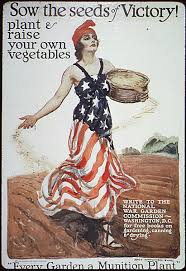Any gardeners out there? I admire you and cheer you on but I am not one of you. And yet, I may have been if I had lived back in the time of the World Wars. Ever heard of a Victory Garden? What were they and how did it all work?
Victory gardens, also known as war gardens or food gardens for defense, were vegetable, fruit, and/or herb gardens planted during World War I and World War II to aid the war effort. It was something many could do that weren’t able to serve with troops or join the depleted work force. There were several ways a simple backyard garden or even a community garden plot could make a difference.
The most obvious benefit was to increase the production of fresh fruit and vegetables, even if the production only benefited one family. That was one less family who had to use ration cards for those items at grocery stores. The increased production reduced pressure on the home front food supply as well as reducing demands on commercial farms. Not only that but the communication of patriotism and the morale boost from the gardening were important benefits as well. The idea of war gardens came about during World War I, then by World War II the US government began promoting them, appropriately naming them “Victory Gardens.” The government provided instruction, and seeds, sometimes even land, to individuals and communities for the purpose of growing food.Victory gardens were planted in backyards, churchyards, city parks, playgrounds, vacant lots, and even the edges of baseball diamonds. A spot of unused land suddenly became a place to promote patriotism. If a family grew more than they could use, the surplus was stored and preserved for distribution to families, schools, welfare agencies, and for local emergency food needs. The Department of Agriculture and the War Production Board came up with a special Victory Garden fertilizer for home use. Pamphlets were printed to show people how to grow enough food to feed their family for a year. A government promotional poster said that by planting gardens, ordinary Americans could "Sow the seeds of Victory" and "plant and raise your own vegetables" - helping the war effort both literally and symbolically. Pretty cool idea – huh?
Victory Gardens introduced people to gardening and to unfamiliar crops like Swiss chard and kohlrabi. Some also raised chickens in their gardens, providing eggs, meat, and also insect control. Community Victory Gardens provided more than a plot of dirt: One newspaper reported that “War news was shared. Recipes and remedies were shared. And gossip too” Many who grew up with Victory Gardens continued gardening throughout their lives and introduced it to their children.
What about you? Would you have planted a Backyard Victory Garden or perhaps been a part of a community garden effort during a World War? Big or small - it all mattered!
Scribbling in notebooks has been a habit of Cindy Regnier since she was old enough to hold a pencil. Born and raised in Kansas, she writes stories of historical Kansas, especially the Flint Hills area where she spent much of her childhood. Her experiences with the Flint Hills setting, her natural love for history, farming and animals, along with her interest in genealogical research give her the background and passion to write heart-fluttering historical romance.








Thank you for posting today, and Happy holiday season to you and your family. I do think that we would have tried to participate in an effort like the Victory Garden.
ReplyDeleteHi Connie. Thanks for your comment. Hope you had a wonderful Christmas and a great 2025 is in store for you
ReplyDelete